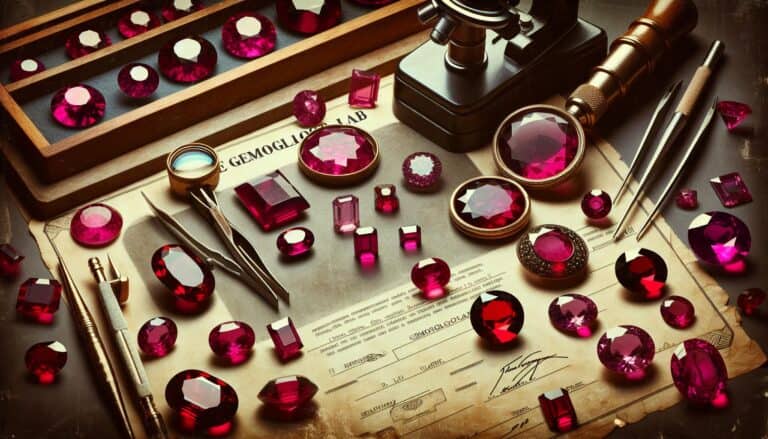Diving into the world of gems can be as thrilling as it is lucrative.
Whether you’re drawn to the sparkle of diamonds or the deep hues of sapphires, buying and selling gems is an art that combines passion with savvy investment. You’re about to unlock the secrets that can turn a simple interest into a profitable venture.
Navigating the gem market requires knowledge and finesse. From understanding the 4 C’s of diamonds to recognizing the potential in lesser-known stones, you’ll need to arm yourself with information. But don’t worry, you’re on the right path. With the right guidance, you’ll be making smart choices that could pay off handsomely.
As you embark on this glittering journey, remember that every gem tells a story. It’s not just about the transaction; it’s about the thrill of the hunt and the joy of the find. Ready to get started?
Let’s explore the facets of buying and selling gems that could make you shine in this sparkling industry.
The Gem trade is a blend of passion and savvy investment. Master market intricacies, from diamond’s 4 C’s to rare gems’ allure. Navigate legalities, authenticate rigorously, and immerse in the community. Beyond profit, it’s the thrill of discovery, offering a unique mix of intrigue and opportunity.
Understanding the Gem Market
When you’re diving into the world of gems, it’s vital that you grasp the complexities of the gem market. The market is as diverse as the stones it proffers, ranging from high-value diamonds and sapphires to the more obscure, yet equally fascinating, semi-precious stones like peridot or moonstone.
Supply and demand play a critical role in the valuation of gems. Rare finds such as red diamonds or Kashmir sapphires often command astronomical prices due to their scarcity. Conversely, even with impeccable qualities, abundant gems like amethysts typically have lower price points.
To thrive in gem trading, it’s essential to stay informed. This means keeping an eye on:
- Market trends
- Auction results
- Price fluctuations of different gemstones
Jewelry fairs and exhibitions are excellent venues for gauging the pulse of the market. They’re not only great for witnessing the current demand but also for networking with industry insiders.
Another aspect you can’t afford to ignore is provenance. The story of where a gem comes from can sometimes be as valuable as the gem itself. Provenance can impact the value due to factors like historical significance or the gem’s mining conditions. Ethical sourcing is becoming increasingly important in buyers’ decisions.
Lastly, it’s about knowing the right time to buy or sell. Gems can appreciate over time, making them a good investment if you know when to make your move. But timing is everything; buying during a surplus could mean lower prices, and selling during a drought could yield higher returns.
By understanding these subtleties, you’re setting yourself up for success—knowing when to seize the opportunity or when to exercise patience. Each gem you encounter carries a myriad of factors affecting its value, and it’s your job to dissect and comprehend these nuances. With steadfast research and a sharp eye, you’ll learn to navigate the gem market with the acumen of a seasoned trader.
The 4 C’s of Diamonds
When diving into the diamond market, you’ll quickly encounter the term “the 4 C’s.” These criteria are crucial in determining a diamond’s value and appeal. Here’s what you need to know.
Carat Weight refers to how much a diamond weighs, with one carat equating to 0.2 grams. As carat weight increases, so does the price, but the cost doesn’t always rise linearly. Larger diamonds are rarer and more desirable, often commanding a higher price per carat.
Clarity is about the absence of inclusions and blemishes inside or on the surface of a diamond. These imperfections can detract from the stone’s beauty and impede its brilliance. Clarity grades range from Flawless (no inclusions visible under 10x magnification) to Included, which contains visible imperfections to the naked eye.
| Clarity Grade | Description |
|---|---|
| FL | Flawless |
| IF | Internally Flawless |
| VVS1-VVS2 | Very Very Slightly Included |
| VS1-VS2 | Very Slightly Included |
| SI1-SI2 | Slightly Included |
| I1-I3 | Included |
Color in diamonds is actually about the lack thereof. The most prized diamonds are completely colorless, allowing more light to pass through and creating a dazzling sparkle. Diamonds are graded on a color scale from D (colorless) to Z (light yellow or brown).
Cut does not just refer to a diamond’s shape but also its proportions, symmetry, and how well it’s been polished. A well-cut diamond will reflect light internally from one mirror-like facet to another and disperse it through the top of the stone, resulting in a fiery brilliance.
Understanding these 4 C’s will equip you to make savvy decisions. Each C interacts with the others – for example, a high-carat diamond with poor clarity might be less valuable than a smaller, clearer diamond. Keep in mind that the 4 C’s are just the starting point in your diamond evaluation journey.
Exploring Lesser-Known Stones
While diamonds, sapphires, and rubies capture most of the limelight, there’s a fascinating world of lesser-known gemstones that offer unique beauty and value. Learning about these hidden gems not only broadens your knowledge but can also uncover lucrative opportunities in the gem market.
Tanzanite, for example, boasts deep blue and violet hues and is found exclusively in Tanzania. It’s recently gained popularity but still remains more affordable than some traditional stones. Similarly, Tsavorite, a vivid green garnet discovered in the 1960s, presents a stunning alternative to emeralds at a fraction of the price.
Why Consider Lesser-Known Gems?
- Exclusivity: These gems are not as readily available, making them unique additions to any collection.
- Price: Comparatively lower prices can lead to greater affordability for buyers and profit margins for you as a seller.
- Niche Market: With fewer people dealing in these stones, you’ll face less competition.
Diversifying Your Portfolio
Diversifying your gem portfolio with these stones could minimize risks associated with market volatility. Spinel, with its array of colors from vibrant reds to cobalt blues, is an excellent example. Once mistaken for rubies, spinels have carved out their own niche and are increasingly sought after by collectors and jewelry enthusiasts.
When evaluating gems like Morganite, with its soft pink to orange-pink hues, factor in the trends toward pastel-colored stones in jewelry. Consider also unique stones such as Alexandrite, which changes color based on the lighting, offering a captivating visual experience.
Evaluating Market Position
Understanding the current market position of these less mainstream gems is critical. Monitor auction results and engage with niche communities to gauge interest and demand. Be mindful of the potential for certain stones to become fashionable, which can swiftly increase their value.
Remember that knowledge is power in the gem market. By exploring the appeal of lesser-known stones, you’re unlocking potential and paving your way toward informed buying and selling decisions. Keep in mind the 4 C’s and the nuances that might make these hidden gems a smart investment or the perfect distinctive piece for your collection.
The Art of Buying and Selling Gems
Buying and selling gems is not just a transaction; it’s an art form that requires knowledge, patience, and strategic thinking. The gem market is vast and varied, so understanding the nuances of each type of gemstone is key. To excel, you’ll want to cultivate a keen eye for quality and develop relationships with reputable sellers.
When you’re looking to buy, consider the 4Cs—color, clarity, cut, and carat weight—which are the universal standards for evaluating the quality of gemstones. But don’t stop there; delve deeper into the specific characteristics that make each gem unique. For example, the presence of certain inclusions in emeralds can be accepted, whereas in diamonds it significantly reduces their value.
- Pay attention to trends and consumer demand. Just like fashion, certain gemstones can become popular, increasing their market value. Keeping up with such trends can give you an edge.
- Learn about the gemstone’s origin as provenance can greatly affect its value.
On the selling side, timing is crucial. Gems don’t have a set market price that fluctuates daily like the stock market. Instead, their value appreciates over time. You’ll need to gauge the right moment to sell, which may come down to supply and demand dynamics.
Market Research and Networking
In-depth market research is essential in both buying and selling. You should:
- Attend gem shows to observe the market firsthand.
- Keep an eye on auction house catalogs and results to recognize pricing patterns.
- Network with industry professionals at trade fairs and online forums. They’re often the first to know about shifts in the market.
Remember, your network is your net worth in the gem industry. The more you connect with peers and experts, the better informed your buying and selling decisions will be, and the more opportunities you’ll encounter.
By understanding the intrinsic value and market demand, you can buy gems that will hold their value or appreciate, and sell when the market peak aligns with buyers’ interests. Navigating the complexities of the gem market takes practice, but with a combination of research, networking, and a bit of intuition, you can join the ranks of those who master the art of dealing in precious stones.
The Thrill of the Hunt
Gems hold a certain allure that can turn the typical buying and selling process into an exciting endeavor. You’re not just purchasing an item; you’re embarking on a quest to find rarity, beauty, and value that often lies hidden beneath the ordinary. The thrill lies in uncovering a gemstone that not only matches your criteria for the 4Cs but also tells a story and embodies a character all its own.
When hunting for these precious stones, remember that each gem has its own tale. Origin and history add layers of intrigue to your potential investment. This is why attending gem shows, auctions, and estate sales can be incredibly rewarding. Here, you could uncover a piece with a legacy that may significantly enhance its market value. Your presence in these places also facilitates networking, granting you access to exclusive gem circles and insider knowledge.
The search for the perfect gem often requires extensive travel, as some of the most sought-after pieces are found in remote locations. Whether it’s the lush green emerald mines of Colombia, the deep red ruby hearts of Myanmar, or the sapphire-rich soils of Madagascar, your adventure could take you across the globe. Always verify authenticity and ethical sourcing during these excursions to ensure that your gem’s value is not compromised.
Arm yourself with a keen eye for detail and patience during your quest. Finding a true gem often involves sifting through a plethora of stones, understanding their potential, and envisioning their future worth. Stay vigilant about current market trends and consumer appetites because these will dictate how well your new found gems will fare in the market.
Your pursuit in the gem market is more than a transaction—it’s a chase after the extraordinary. Align your hunting strategies with extensive research and know that sometimes, it’s that rare discovery or unexpected deal that makes the journey worthwhile. Keep refining your approach and utilize every interaction to hone your gem hunting acumen.
Conclusion: How Much Are Gems Worth?
Venturing into the gem market can be as exhilarating as it is lucrative.
You’ve got the tools: a keen understanding of the 4Cs, an eye for trends, and the savvy to conduct thorough market research. Remember, your network is invaluable—forge relationships that will afford you insider knowledge and opportunities. Trust your intuition but back it up with solid facts and ethical considerations. Whether you’re in it for the thrill of the hunt or the long-term investment, gems offer a unique path to financial growth.
Stay informed, stay connected, and you might just find that buying and selling gems is your hidden gem of an enterprise.







